Human Capital and Carbon Emissions: The Way forward Reducing Environmental Degradation
Abstract
1. Introduction
2. Literature Review
3. Methodology
- CO2 = CO2 emissions per capita
- HC = Human capital index
- GDP = Per capita GDP
- URB = Urban population growth rate
- FDI = FDI net Inflows as a percentage of GDP.
4. Results
4.1. Pretest Analysis Results
4.2. Long-Run and Short-Run Dynamics
4.3. Diagnostic Tests Results
5. Discussion
6. Conclusions
Author Contributions
Funding
Institutional Review Board Statement
Informed Consent Statement
Data Availability Statement
Conflicts of Interest
References
- Rahman, M.M.; Nepal, R.; Alam, K. Impacts of human capital, exports, economic growth and energy consumption on CO2 emissions of a cross-sectionally dependent panel: Evidence from the newly industrialized countries (NICs). Environ. Sci. Policy 2021, 121, 24–36. [Google Scholar] [CrossRef]
- Wu, W.; Ma, X.; Zhang, Y.; Li, W.; Wang, Y. A novel conformable fractional non-homogeneous grey model for forecasting carbon dioxide emissions of BRICS countries. Sci. Total Environ. 2020, 707, 135447. [Google Scholar] [CrossRef]
- Grossman, G.; Krueger, A. Environmental Impacts of a North American Free Trade Agreement. Natl. Bur. Econ. Res. 1991, 3914, 14–22. [Google Scholar] [CrossRef]
- Ahmad, A.; Zhao, Y.; Shahbaz, M.; Bano, S.; Zhang, Z.; Wang, S.; Liu, Y. Carbon emissions, energy consumption and economic growth: An aggregate and disaggregate analysis of the Indian economy. Energy Policy 2016, 96, 131–143. [Google Scholar] [CrossRef]
- Yao, X.; Yasmeen, R.; Haq Padda, I.U.; Hassan Shah, W.U.; Kamal, M.A. Inequalities by energy sources: An assessment of environmental quality. PLoS ONE 2020, 15, e0230503. [Google Scholar] [CrossRef] [PubMed]
- Akram, V.; Jangam, B.P.; Rath, B.N. Does human capital matter for reduction in energy consumption in India? Int. J. Energy Sect. Manag. 2019, 13, 359–376. [Google Scholar] [CrossRef]
- Salim, R.; Yao, Y.; Chen, G.S. Does human capital matter for energy consumption in China? Energy Econ. 2017, 67, 49–59. [Google Scholar] [CrossRef]
- Shahbaz, M.; Kumar Tiwari, A.; Nasir, M. The effects of financial development, economic growth, coal consumption and trade openness on CO2 emissions in South Africa. Energy Policy 2013, 61, 1452–1459. [Google Scholar] [CrossRef]
- Wei, Y.; Zhu, X.; Li, Y.; Yao, T.; Tao, Y. Influential factors of national and regional CO2 emission in China based on combined model of DPSIR and PLS-SEM. J. Clean. Prod. 2019, 212, 698–712. [Google Scholar] [CrossRef]
- Sohag, K.; Begum, R.A.; Syed Abdullah, S.M.; Jaafar, M. Dynamics of energy use, technological innovation, economic growth and trade openness in Malaysia. Energy 2015, 90, 1497–1507. [Google Scholar] [CrossRef]
- Hao, Y.; Wu, Y.; Wu, H.; Ren, S. How do FDI and technical innovation affect environmental quality? Evidence from China. Environ. Sci. Pollut. Res. 2020, 27, 7835–7850. [Google Scholar] [CrossRef]
- Ali, R.; Bakhsh, K.; Yasin, M.A. Impact of urbanization on CO2 emissions in emerging economy: Evidence from Pakistan. Sustain. Cities Soc. 2019, 48, 101553. [Google Scholar] [CrossRef]
- Nasreen, S.; Anwar, S. Causal relationship between trade openness, economic growth and energy consumption: A panel data analysis of Asian countries. Energy Policy 2014, 69, 82–91. [Google Scholar] [CrossRef]
- Bakhsh, S.; Yin, H.; Shabir, M. Foreign investment and CO2 emissions: Do technological innovation and institutional quality matter? Evidence from system GMM approach. Environ. Sci. Pollut. Res. 2021, 28, 19424–19438. [Google Scholar] [CrossRef]
- Demena, B.A.; Afesorgbor, S.K. The effect of FDI on environmental emissions: Evidence from a meta-analysis. Energy Policy 2020, 138, 111192. [Google Scholar] [CrossRef]
- Li, Z.; Dong, H.; Huang, Z.; Failler, P. Impact of foreign direct investment on environmental performance. Sustainability 2019, 11, 3538. [Google Scholar] [CrossRef]
- Wang, S.; Li, Q.; Fang, C.; Zhou, C. The relationship between economic growth, energy consumption, and CO2 emissions: Empirical evidence from China. Sci. Total Environ. 2016, 542, 360–371. [Google Scholar] [CrossRef]
- Wang, Y.; Chen, L.; Kubota, J. The relationship between urbanization, energy use and carbon emissions: Evidence from a panel of Association of Southeast Asian Nations (ASEAN) countries. J. Clean. Prod. 2016, 112, 1368–1374. [Google Scholar] [CrossRef]
- Gasimli, O.; Haq, I.U.; Gamage, S.K.N.; Shihadeh, F.; Rajapakshe, P.S.K.; Shafiq, M. Energy, Trade, Urbanization and Environmental Degradation Nexus in Sri Lanka: Bounds Testing Approach. Energies 2019, 12, 1655. [Google Scholar] [CrossRef]
- Muhammad, S.; Long, X.; Salman, M.; Dauda, L. Effect of urbanization and international trade on CO2 emissions across 65 belt and road initiative countries. Energy 2020, 196, 117102. [Google Scholar] [CrossRef]
- Li, P.; Ouyang, Y. The dynamic impacts of financial development and human capital on CO2 emission intensity in china: An ardl approach. J. Bus. Econ. Manag. 2019, 20, 939–957. [Google Scholar] [CrossRef]
- Komal, R.; Abbas, F. Linking financial development, economic growth and energy consumption in Pakistan. Renew. Sustain. Energy Rev. 2015, 44, 211–220. [Google Scholar] [CrossRef]
- Al-mulali, U.; Binti Che Sab, C.N. The impact of energy consumption and CO2 emission on the economic growth and financial development in the Sub Saharan African countries. Energy 2012, 39, 180–186. [Google Scholar] [CrossRef]
- Ozturk, I.; Acaravci, A. The long-run and causal analysis of energy, growth, openness and financial development on carbon emissions in Turkey. Energy Econ. 2013, 36, 262–267. [Google Scholar] [CrossRef]
- Wang, Z.X.; Li, Q. Modelling the nonlinear relationship between CO2 emissions and economic growth using a PSO algorithm-based grey Verhulst model. J. Clean. Prod. 2019, 207, 214–224. [Google Scholar] [CrossRef]
- Wang, Z.X.; Hao, P.; Yao, P.Y. Non-linear relationship between economic growth and CO2 emissions in China: An empirical study based on panel smooth transition regression models. Int. J. Environ. Res. Public Health 2017, 14, 1568. [Google Scholar] [CrossRef]
- Vo, A.T.; Vo, D.H.; Le, Q.T.T. CO2 Emissions, Energy Consumption, and Economic Growth: New Evidence in the ASEAN Countries. J. Risk Financ. Manag. 2019, 12, 145. [Google Scholar] [CrossRef]
- Ahmed, Z.; Wang, Z. Investigating the impact of human capital on the ecological footprint in India: An empirical analysis. Environ. Sci. Pollut. Res. 2019, 26, 26782–26796. [Google Scholar] [CrossRef] [PubMed]
- Gnangoin, T.Y.; Kassi, D.F.; Edjoukou, A.J.R.; Kongrong, O.Y.; Yuqing, D. Renewable energy, non-renewable energy, economic growth and CO2 emissions in the newly emerging market economies: The moderating role of human capital. Front. Environ. Sci. 2022, 10, 1–15. [Google Scholar] [CrossRef]
- Yao, Y.; Ivanovski, K.; Inekwe, J.; Smyth, R. Human capital and CO2 emissions in the long run. Energy Econ. 2020, 91, 104907. [Google Scholar] [CrossRef]
- Syed, A.A.; Kamal, M.A.; Tripathi, R. An empirical investigation of nuclear energy and environmental pollution nexus in India: Fresh evidence using NARDL approach. Environ. Sci. Pollut. Res. 2021, 28, 54744–54755. [Google Scholar] [CrossRef] [PubMed]
- Bano, S.; Zhao, Y.; Ahmad, A.; Wang, S.; Liu, Y. Identifying the impacts of human capital on carbon emissions in Pakistan. J. Clean. Prod. 2018, 183, 1082–1092. [Google Scholar] [CrossRef]
- Kim, D.; Go, S. Human capital and environmental sustainability. Sustainability 2020, 12, 4736. [Google Scholar] [CrossRef]
- Gorham, E.; Lehman, C.; Kelly, J. Relationships of the Environmental Performance Index to Six Interrelated Variables in Nations Around the World. Bull. Ecol. Soc. Am. 2019, 100, e01525. [Google Scholar] [CrossRef]
- Hettige, H.; Huq, M.; Pargal, S.; Wheeler, D. Determinants of pollution abatement in developing countries: Evidence from South and Southeast Asia. World Dev. 1996, 24, 1891–1904. [Google Scholar] [CrossRef]
- Lan, J.; Munro, A. Environmental compliance and human capital: Evidence from Chinese industrial firms. Resour. Energy Econ. 2013, 35, 534–557. [Google Scholar] [CrossRef]
- Ali, G.; Ashraf, A.; Bashir, M.K.; Cui, S. Exploring environmental Kuznets curve (EKC) in relation to green revolution: A case study of Pakistan. Environ. Sci. Policy 2017, 77, 166–171. [Google Scholar] [CrossRef]
- Dias, J.; McDermott, J. Institutions, education, and development: The role of entrepreneurs. J. Dev. Econ. 2006, 80, 299–328. [Google Scholar] [CrossRef]
- Pablo-Romero, M.d.P.; Sánchez-Braza, A. Productive energy use and economic growth: Energy, physical and human capital relationships. Energy Econ. 2015, 49, 420–429. [Google Scholar] [CrossRef]
- Kwon, D.-B. Human capital and its measurement. In Proceedings of the 3rd OECD World Forum on “Statistics, Knowledge and Policy” Charting Progress, Building Visions, Improving Life, Busan, Republic of Korea, 27–30 October 2009. [Google Scholar]
- Goetz, S.J.; Debertin, D.L.; Pagoulatos, A. Human Capital, Income, and Environmental Quality: A State-Level Analysis. Agric. Resour. Econ. Rev. 1998, 27, 200–208. [Google Scholar] [CrossRef]
- Delbeke, J.; Vis, P. Towards a climate-neutral Europe: Curbing the trend; Routledge: New York, NY, USA, 2019; pp. 24–43. [Google Scholar]
- USAID. Greenhouse Gas Emissions in Sri Lanka, 2014–2015; USAID: Washington, DC, USA, 2015.
- Huang, C.; Zhang, X.; Liu, K. Effects of human capital structural evolution on carbon emissions intensity in China: A dual perspective of spatial heterogeneity and nonlinear linkages. Renew. Sustain. Energy Rev. 2021, 135, 110258. [Google Scholar] [CrossRef]
- Naradda Gamage, S.K.; Hewa Kuruppuge, R.; Haq, I. ul Energy consumption, tourism development, and environmental degradation in Sri Lanka. Energy Sources Part B Econ. Plan. Policy 2017, 12, 910–916. [Google Scholar] [CrossRef]
- Uddin, M.G.S.; Bidisha, S.H.; Ozturk, I. Carbon emissions, energy consumption, and economic growth relationship in Sri Lanka. Energy Sources Part B Econ. Plan. Policy 2016, 11, 282–287. [Google Scholar] [CrossRef]
- Stein, F.; Sridhar, D. Back to the future? Health and the World Bank’s human capital index. BMJ 2019, 367, 10–12. [Google Scholar] [CrossRef]
- Yao, Y.; Zhang, L.; Salim, R.; Rafiq, S. The effect of human capital on CO2 emissions: Macro evidence from China. Energy J. 2020, 42, 67–96. [Google Scholar] [CrossRef]
- Sasana, H.; Putri, A.E. The Increase of Energy Consumption and Carbon Dioxide (CO2) Emission in Indonesia. In E3S Web of Conferences; EDP Sciences: Les Ulis, France, 2018; p. 01008. [Google Scholar]
- Fatai, F.; Zakari, A. Science of the Total Environment Energy consumption, economic expansion, and CO2 emission in the UK: The role of economic policy uncertainty CO2 Emissions in the UK. Sci. Total Environ. 2020, 738, 140014. [Google Scholar] [CrossRef]
- Satterthwaite, D. The implications of population growth and urbanization for climate change. Environ. Urban. 2009, 21, 545–567. [Google Scholar] [CrossRef]
- Khan, Z.; Ali, S.; Dong, K.; Li, R.Y.M. How does fiscal decentralization affect CO2 emissions? The roles of institutions and human capital. Energy Econ. 2021, 94, 105060. [Google Scholar] [CrossRef]
- Balaguer, J.; Cantavella, M. The role of education in the Environmental Kuznets Curve. Evidence from Australian data. Energy Econ. 2018, 70, 289–296. [Google Scholar] [CrossRef]
- Blackman, A.; Kildegaard, A. Clean technological change in developing-country industrial clusters: Mexican leather tanning. Environ. Econ. Policy Stud. 2010, 12, 115–132. [Google Scholar] [CrossRef]
- Gangadharan, L. Environmental compliance by firms in the manufacturing sector in Mexico. Ecol. Econ. 2006, 59, 477–486. [Google Scholar] [CrossRef]
- Dasgupta, S.; Hettige, H.; Wheeler, D. What improves environmental compliance? Evidence from Mexican industry. J. Environ. Econ. Manage. 2000, 39, 39–66. [Google Scholar] [CrossRef]
- Yuan, B.; Zhang, K. Can environmental regulation promote industrial innovation and productivity? Based on the strong and weak Porter hypothesis. Chin. J. Popul. Resour. Environ. 2017, 15, 322–336. [Google Scholar] [CrossRef]
- Zivin, J.G.; Neidell, M. Environment, Health and Human Capital. J. Econ. Lit. 2013, 51, 689–730. [Google Scholar] [CrossRef]
- Chankrajang, T.; Muttarak, R. Green Returns to Education: Does Schooling Contribute to Pro-Environmental Behaviours? Evidence from Thailand. Ecol. Econ. 2017, 131, 434–448. [Google Scholar] [CrossRef]
- Desha, C.; Robinson, D.; Sproul, A. Working in partnership to develop engineering capability in energy efficiency. J. Clean. Prod. 2015, 106, 283–291. [Google Scholar] [CrossRef]
- Ahmed, Z.; Asghar, M.M.; Malik, M.N.; Nawaz, K. Moving towards a sustainable environment: The dynamic linkage between natural resources, human capital, urbanization, economic growth, and ecological footprint in China. Resour. Policy 2020, 67, 101677. [Google Scholar] [CrossRef]
- Shahbaz, M.; Gozgor, G.; Hammoudeh, S. Human capital and export diversification as new determinants of energy demand in the United States. Energy Econ. 2019, 78, 335–349. [Google Scholar] [CrossRef]
- Zhang, L.; Godil, D.I.; Bibi, M.; Khan, M.K.; Sarwat, S.; Anser, M.K. Caring for the environment: How human capital, natural resources, and economic growth interact with environmental degradation in Pakistan? A dynamic ARDL approach. Sci. Total Environ. 2021, 774, 145553. [Google Scholar] [CrossRef]
- Mahmood, N.; Wang, Z.; Hassan, S.T. Renewable energy, economic growth, human capital, and CO2 emission: An empirical analysis. Environ. Sci. Pollut. Res. 2019, 26, 20619–20630. [Google Scholar] [CrossRef]
- Pata, U.K.; Caglar, A.E. Investigating the EKC hypothesis with renewable energy consumption, human capital, globalization and trade openness for China: Evidence from augmented ARDL approach with a structural break. Energy 2021, 216, 119220. [Google Scholar] [CrossRef]
- Sarkodie, S.A.; Adams, S.; Owusu, P.A.; Leirvik, T.; Ozturk, I. Mitigating degradation and emissions in China: The role of environmental sustainability, human capital and renewable energy. Sci. Total Environ. 2020, 719, 137530. [Google Scholar] [CrossRef] [PubMed]
- Hassan, S.T.; Xia, E.; Huang, J.; Khan, N.H.; Iqbal, K. Natural resources, globalization, and economic growth: Evidence from Pakistan. Environ. Sci. Pollut. Res. 2019, 26, 2929–2938. [Google Scholar] [CrossRef] [PubMed]
- Danish, H.S.; Hassan, S.T.; Baloch, M.A.; Mahmood, N.; Zhang, J.W. Linking economic growth and ecological footprint through human capital and biocapacity. Sustain. Cities Soc. 2019, 47, 101516. [Google Scholar] [CrossRef]
- Yao, Y.; Ivanovski, K.; Inekwe, J.; Smyth, R. Human capital and energy consumption: Evidence from OECD countries. Energy Econ. 2019, 84, 104534. [Google Scholar] [CrossRef]
- Nathaniel, S.P.; Nwulu, N.; Bekun, F. Natural resource, globalization, urbanization, human capital, and environmental degradation in Latin American and Caribbean countries. Environ. Sci. Pollut. Res. 2021, 28, 6207–6221. [Google Scholar] [CrossRef]
- Li, X.; Ullah, S. Caring for the environment: How CO2 emissions respond to human capital in BRICS economies? Environ. Sci. Pollut. Res. 2022, 29, 18036–18046. [Google Scholar] [CrossRef]
- Lin, X.; Zhao, Y.; Ahmad, M.; Ahmed, Z.; Rjoub, H.; Adebayo, T.S. Linking innovative human capital, economic growth, and Co2 emissions: An empirical study based on Chinese provincial panel data. Int. J. Environ. Res. Public Health 2021, 18, 8503. [Google Scholar] [CrossRef]
- Sapkota, P.; Bastola, U. Foreign direct investment, income, and environmental pollution in developing countries: Panel data analysis of Latin America. Energy Econ. 2017, 64, 206–212. [Google Scholar] [CrossRef]
- Dietz, T.; Rosa, E.A. Effects of population and affluence on CO2 emissions. Proc. Natl. Acad. Sci. USA 1997, 94, 175–179. [Google Scholar] [CrossRef]
- Niu, H.; Lekse, W. Carbon emission effect of urbanization at regional level: Empirical evidence from China. Economics 2018, 12, 1–31. [Google Scholar] [CrossRef]
- Khan, A.Q.; Saleem, N.; Fatima, S.T. Financial development, income inequality, and CO2 emissions in Asian countries using STIRPAT model. Environ. Sci. Pollut. Res. 2018, 25, 6308–6319. [Google Scholar] [CrossRef]
- Assamoi, G.R.; Wang, S.; Liu, Y.; Gnangoin, T.B.Y.; Kassi, D.F.; Edjoukou, A.J.R. Dynamics between participation in global value chains and carbon dioxide emissions: Empirical evidence for selected Asian countries. Environ. Sci. Pollut. Res. 2020, 27, 16496–16506. [Google Scholar] [CrossRef]
- Our World in Data. Available online: https://ourworldindata.org/grapher/co2-per-capita-vs-renewable-electricity (accessed on 9 September 2022).
- Feenstra, R.C.; Inklaar, R.; Timmer, M.P. The Next Generation of the Penn World Table. Am. Econ. Rev. 2015, 105, 3150–3182. Available online: http://www.ggdc.net/pwt/ (accessed on 9 September 2022). [CrossRef]
- WDI, Word Development Indicators. Available online: https://databank.worldbank.org/source/world-development-indicators (accessed on 7 July 2022).
- BP: BP Statistical Review of World Energy June 2020. Available online: https://www.bp.com/en/global/corporate/energy-economics/statistical-review-of-world-energy.html (accessed on 7 July 2022).
- Charfeddine, L.; Mrabet, Z. The impact of economic development and social-political factors on ecological footprint: A panel data analysis for 15 MENA countries. Renew. Sustain. Energy Rev. 2017, 76, 138–154. [Google Scholar] [CrossRef]
- Engele, R.F.; Granger, C.W.R. Co-Integration and Error Correction.pdf. Econometrica 1987, 55, 251–276. [Google Scholar] [CrossRef]
- Johamen, S.; Jtiselius, K. Maximum likelihood estimation and inference on cointegration—With appucations to the demand for money. Oxf. Bull. Econ. Stat. 1990, 52, 169–210. [Google Scholar]
- Phillips, P.C.B.; Hansen, B.E. Statistical inference in instrumental variables regression with i(1) processes. Rev. Econ. Stud. 1990, 57, 99–125. [Google Scholar] [CrossRef]
- Zafar, M.W.; Zaidi, S.A.H.; Khan, N.R.; Mirza, F.M.; Hou, F.; Kirmani, S.A.A. The impact of natural resources, human capital, and foreign direct investment on the ecological footprint: The case of the United States. Resour. Policy 2019, 63, 101428. [Google Scholar] [CrossRef]
- Shin, Y.; Yu, B. Modeling Asymmetric Cointegration and Dynamic Multipliers in a Nonlinear ARDL Framework. In Festschrift in Honor of Peter Schmidt: Econometric Methods and Applications; Horrace, W.C., Sickles, R.C., Eds.; Springer Science & Business Media: New York, NY, USA, 2014; pp. 281–314. [Google Scholar] [CrossRef]
- Perron, B.Y.P. The great crash, the oil price shock, and the unit root hypothesis. Econom. Soc. Stable 1989, 57, 1361–1401. [Google Scholar] [CrossRef]
- Zivot, E.; Andrews, D.W.K. Further evidence on the great crash, the oil-price shock, and the unit-root hypothesis. J. Bus. Econ. Stat. 1992, 10, 251–270. [Google Scholar] [CrossRef]
- ADB. UNDP Assessment of Sri Lanka’s Power Sector-100% Electricity Generation Through Renewable Energy by 2050. Available online: https://www.ndcs.undp.org/content/dam/LECB/docs/pubs-reports/UNDP-LECB-Assessment-Sri-Lanka-Power-Sector.pdf (accessed on 14 July 2020).
- Abbasi, M.A.; Parveen, S.; Khan, S.; Kamal, M.A. Urbanization and energy consumption effects on carbon dioxide emissions: Evidence from Asian-8 countries using panel data analysis. Environ. Sci. Pollut. Res. 2020, 27, 18029–18043. [Google Scholar] [CrossRef] [PubMed]
- Charfeddine, L. The impact of energy consumption and economic development on Ecological Footprint and CO2 emissions: Evidence from a Markov Switching Equilibrium Correction Model. Energy Econ. 2017, 65, 355–374. [Google Scholar] [CrossRef]
- Danish; Zhang, B.; Wang, B.; Wang, Z. Role of renewable energy and non-renewable energy consumption on EKC: Evidence from Pakistan. J. Clean. Prod. 2017, 156, 855–864. [Google Scholar] [CrossRef]
- Zaidi, S.A.H.; Zafar, M.W.; Shahbaz, M.; Hou, F. Dynamic linkages between globalization, financial development and carbon emissions: Evidence from Asia Pacific Economic Cooperation countries. J. Clean. Prod. 2019, 228, 533–543. [Google Scholar] [CrossRef]
- Yang, G.; Sun, T.; Wang, J.; Li, X. Modeling the nexus between carbon dioxide emissions and economic growth. Energy Policy 2015, 86, 104–117. [Google Scholar] [CrossRef]
- Hanif, I. Impact of economic growth, nonrenewable and renewable energy consumption, and urbanization on carbon emissions in Sub-Saharan Africa. Environ. Sci. Pollut. Res. 2018, 25, 15057–15067. [Google Scholar] [CrossRef] [PubMed]
- Narayan, P.K.; Saboori, B.; Soleymani, A. Economic growth and carbon emissions. Econ. Model. 2016, 53, 388–397. [Google Scholar] [CrossRef]
- Kim, S. The effects of foreign direct investment, economic growth, industrial structure, renewable and nuclear energy, and urbanization on Korean greenhouse gas emissions. Sustainability 2020, 12, 1625. [Google Scholar] [CrossRef]
- Hille, E.; Shahbaz, M.; Moosa, I. The impact of FDI on regional air pollution in the Republic of Korea: A way ahead to achieve the green growth strategy? Energy Econ. 2019, 81, 308–326. [Google Scholar] [CrossRef]
- Bakhsh, K.; Rose, S.; Ali, M.F.; Ahmad, N.; Shahbaz, M. Economic growth, CO2 emissions, renewable waste and FDI relation in Pakistan: New evidences from 3SLS. J. Environ. Manage. 2017, 196, 627–632. [Google Scholar] [CrossRef] [PubMed]
- Aturupane, H.; Higashi, H.; Ebenezer, R.; Attygalle, D.; Sosale, S.; Dey, S.; Wijesinghe, R. Sri Lanka Human Capital Development: Realizing the Promise and Potential of Human Capital. International Development in Focus; World Bank: Washington, DC, USA, 2021; Available online: http://hdl.handle.net/10986/36113 (accessed on 23 July 2022).
- Sri Lanka: Energy Sector Assessment, Strategy, and Road Map. 2019. Available online: https://dx.doi.org/10.22617/TCS190557-2 (accessed on 8 July 2022).
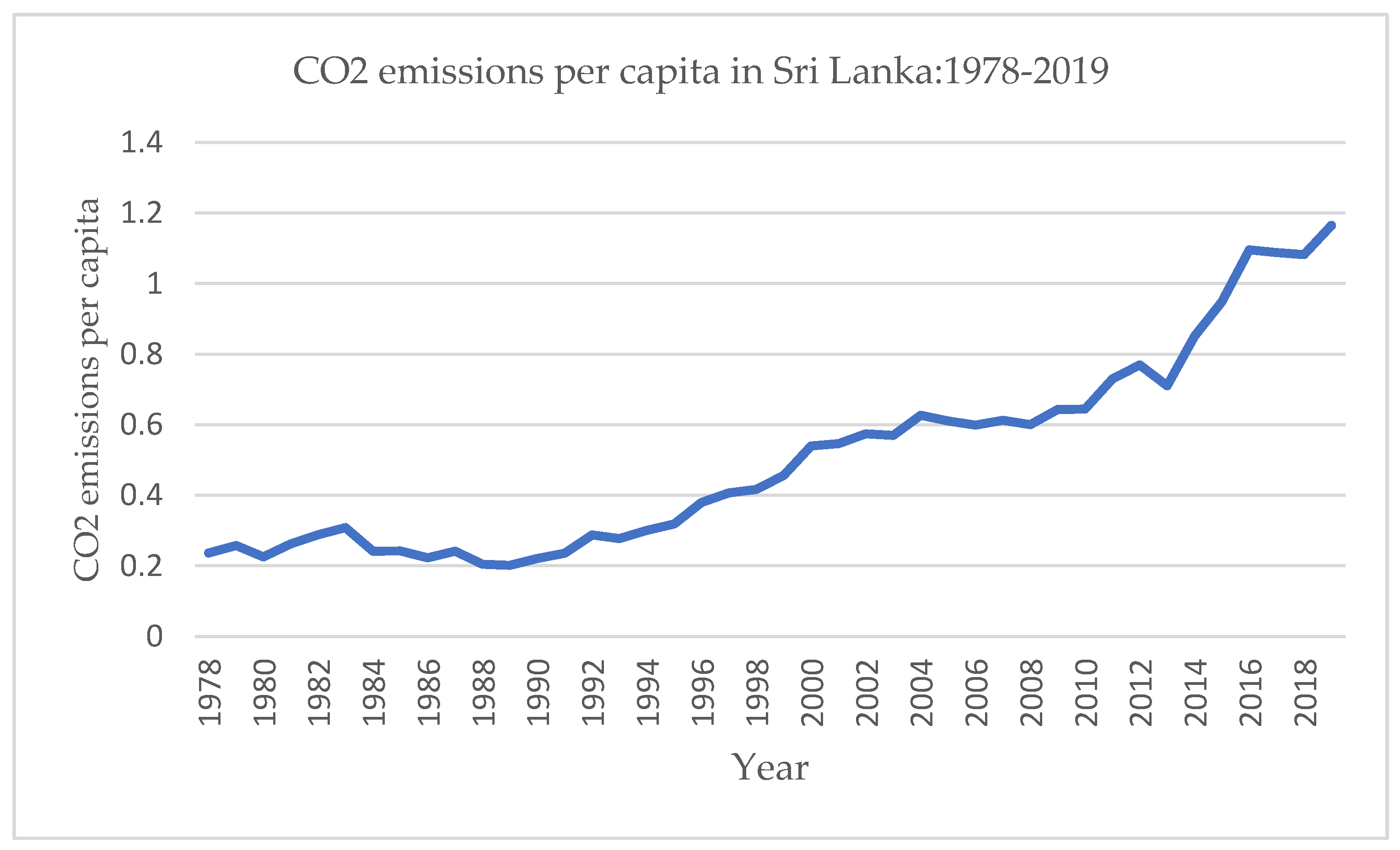
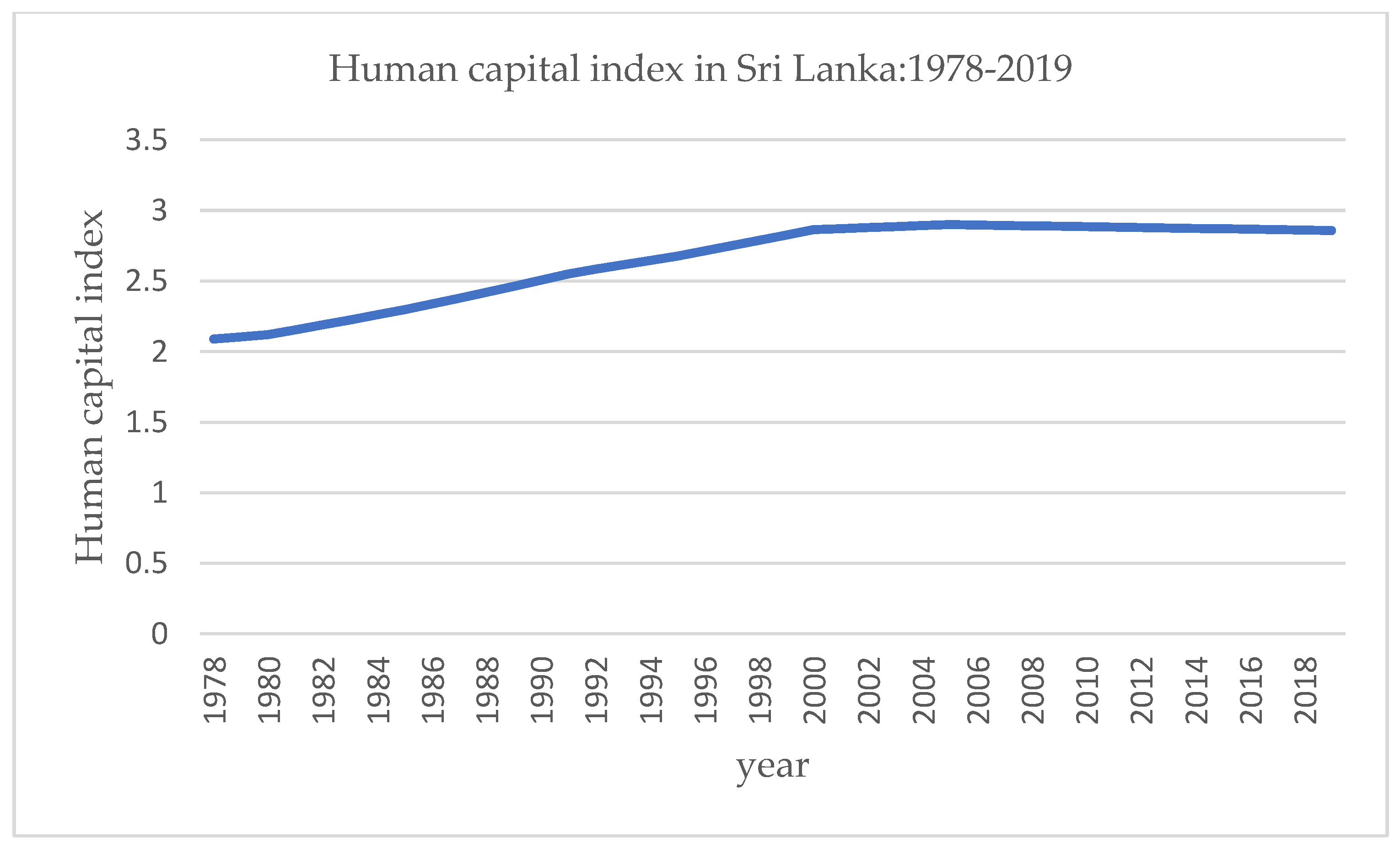
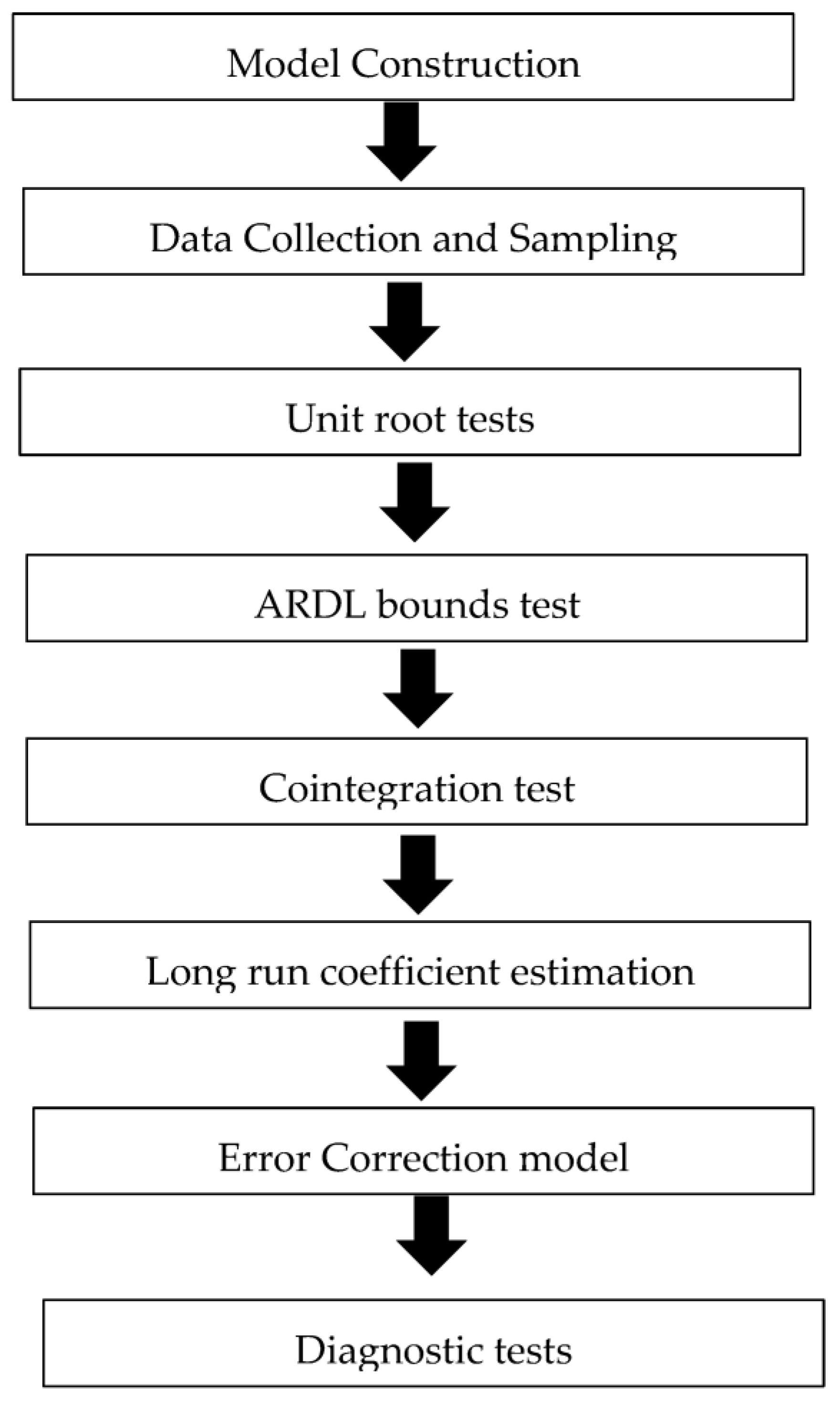
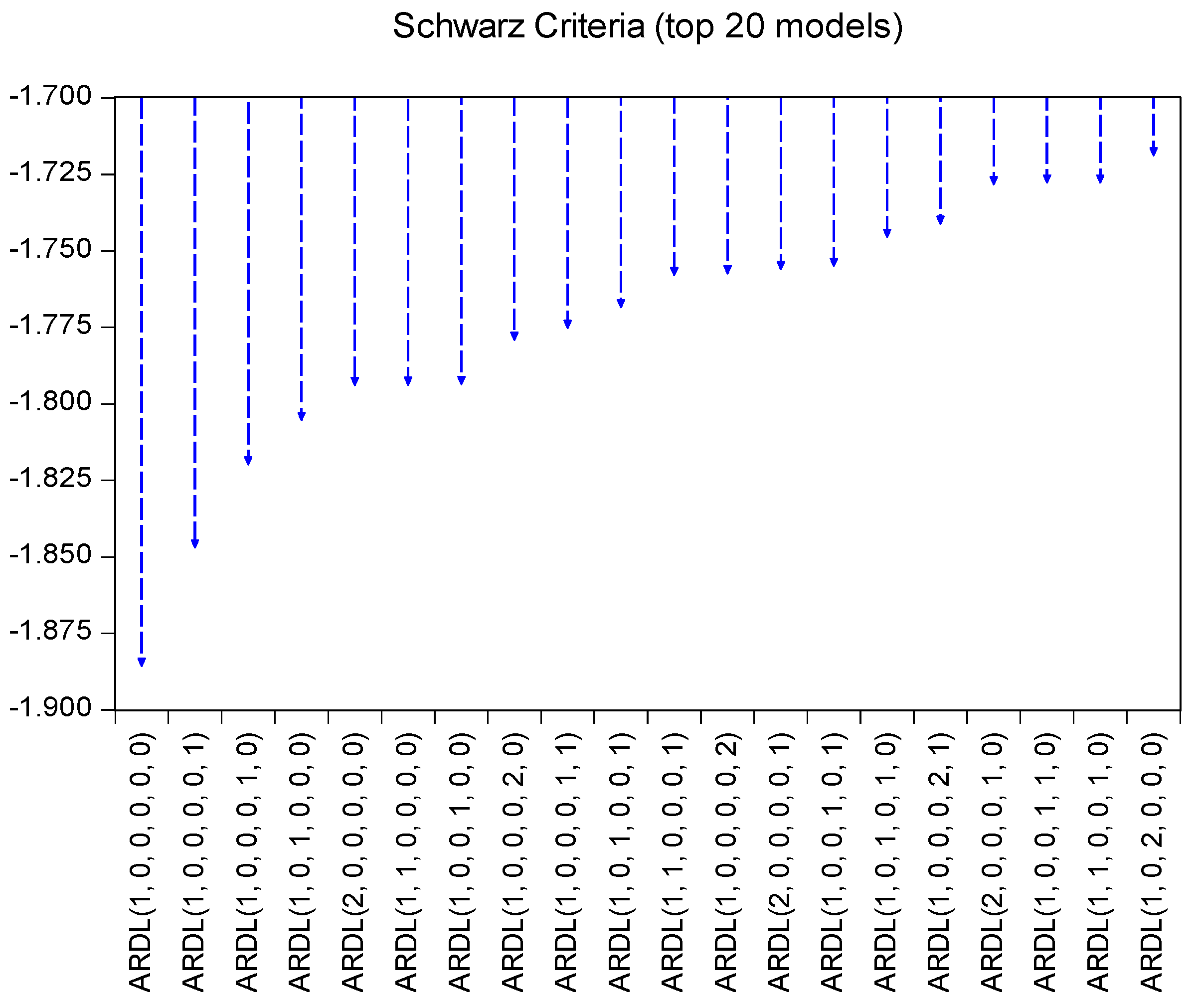
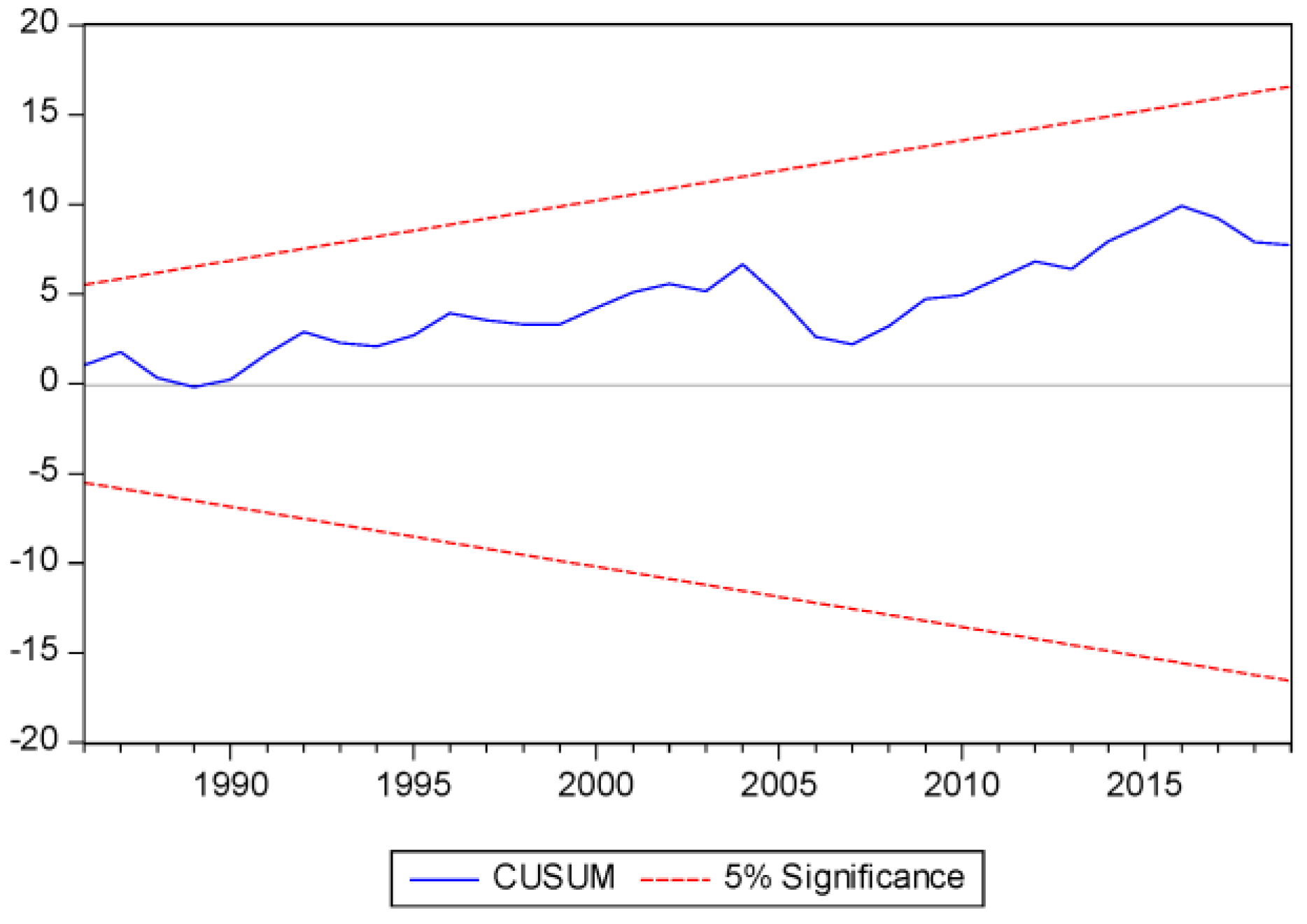
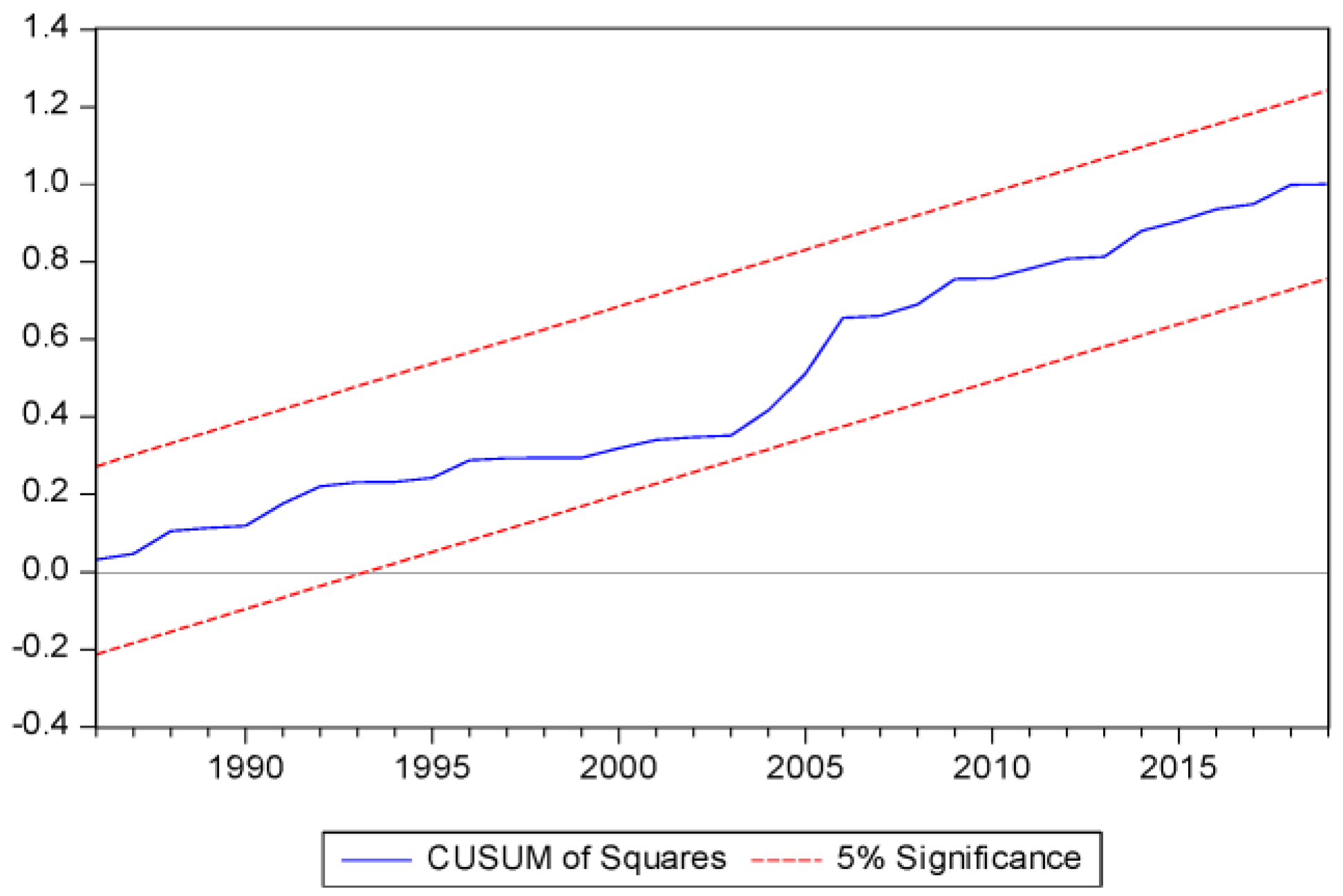
| Researcher(s) | Sample | Number of Countries | Method |
|---|---|---|---|
| Li X et al. (2022) [71] | 1991–2019 | BRICS countries | Non-linear panel ARDL |
| Gnangoin et al. (2022) [29] | 1990–2021 | 20 emerging economies | Generalized least squares (GLS) and two-stage least squares (TSLS) |
| Pata and Caglor (2021) [65] | 1980–2016 | China | ARDL |
| Zhang et al. (2021) [63] | 1985–2018 | Pakistan | ARDL |
| Rahman (2021) [1] | 1979–2017 | Newly industrialized countries (NICs) | FMOLS, DOLS, pooled mean group (PMG) |
| Lin et al. (2021) [72] | 2003–2017 | 30 Chinese provinces | OLS, system generalized method of moments (SYS-GMM) |
| Nathaniel et al. (2021) [70] | 1990–2017 | Latin American and Caribbean countries | Augmented mean group (AMG) |
| Khan et al. (2021) [52] | 1990–2018 | 7 OECD countries | Cross-sectional ARDL (CS-ARDL) |
| Yao Y et al. (2020) [69] | 1870–2014 | OECD countries | OLS |
| Li ouyang (2019) [21] | 1978–2015 | China | ARDL |
| Yao et al. (2019) | 1965–2014 | OECD countries | Cross-sectional dependence (CD) |
| Mahmood et al. (2019) [64] | 1980–2014 | Pakistan | Three-stage least squares (3 SLS) |
| Bano et al. (2018) [32] | 1971–2014 | Pakistan | ARDL and vector error correction (VECM) |
| Sapkota and Bastola (2017) [73] | 1980–2010 | 14 Latin American countries | Panel-fixed and random-effects methods |
| Variable | Symbol | Description | Data source |
|---|---|---|---|
| CO2 Emissions | CO2 | CO2 emissions (tons per capita) | Our World in data [78] |
| Human Capital | HC | Human capital index based on years of schooling and assumed rate return to education | Feenstra et al. (2015) [79] |
| Gross Domestic Product | GDP | Per capita GDP (constant 2010 USD) | World Development Indicators [80] |
| Energy Consumption | EC | Per capita gigajoule of oil equivalent | BP Statistical Review of World Energy [81] |
| Urbanization | URB | Urban population growth rate | World Development Indicators [80] |
| Foreign Direct Investment | FDI | Net inflows as a percentage of GDP | World Development Indicators [80] |
| LNCO2 | LNHC | LNGDP | LNEC | LNURB | LNFDI | |
|---|---|---|---|---|---|---|
| Mean | −0.827823 | 0.968352 | 7.471611 | 2.052030 | −0.106771 | −0.045134 |
| Median | −0.829884 | 1.031918 | 7.438848 | 2.145323 | 0.007533 | 0.109643 |
| Maximum | 0.152668 | 1.064589 | 8.296966 | 2.818720 | 0.859657 | 1.047172 |
| Minimum | −1.601980 | 0.736648 | 6.727785 | 1.348979 | −3.048122 | −2.919806 |
| Std. Dev. | 0.546336 | 0.111118 | 0.489755 | 0.458099 | 0.648859 | 0.653775 |
| Variable | ADF T -Stat. | PP T -Stat. | Status |
|---|---|---|---|
| lnCO2 | −2.050807 | −2.022569 | I (1) |
| ΔlnCO2 | −6.945449 *** | −6.931714 *** | |
| lnHC | 1.290634 | 0.446233 | I (1) |
| ΔlnHC | −3.269384 * | −3.269384 * | |
| lnGDP | −1.918812 | −1.586788 | I (1) |
| ΔlnGDP | −4.330575 *** | −4.330575 *** | |
| lnEC | −1.944247 | −2.168478 | I (1) |
| ΔlnEC | −5.006364 *** | −4.873415 *** | |
| lnURB | −3.668992 ** | −3.612026 ** | 1 (0) |
| ΔlnURB | −6.374327 *** | −14.91526 *** | |
| lnFDI | −1.975037 | −7.508564 | I (1) |
| ΔlnFDI | −3.382546 * | −18.41232 *** |
| Variable | ZA t-Stat. | Structural Break | Variable | ZA t-Stat. | Structural Break |
|---|---|---|---|---|---|
| lnCO2 | −3.812554 ** | 1996 | ΔlnCO2 | −8.066055 | 1990 |
| lnHC | −2.220063 | 1986 | ΔlnHC | −7.083219 *** | 2001 |
| lnGDP | −3.233356 ** | 2010 | ΔlnGDP | −4.699741 | 2003 |
| lnEC | −3.365144 ** | 1997 | ΔlnEC | −5.604818 | 2001 |
| lnURB | −6.202557 *** | 2013 | ΔlnURB | −6.348209 | 1993 |
| lnFDI | −5.884232 *** | 1992 | ΔlnFDI | −7.173892 | 1990 |
| Lag | Logl | LR | FPE | AIC | SC | HQ |
|---|---|---|---|---|---|---|
| 1 | 80.41439 | NA | 8.87 × 10−10 | −3.816123 | −3.560190 | −3.724296 |
| 2 | 368.4023 | 472.5955 | 2.22 × 10−15 | −16.73858 | −14.94705 * | −16.09579 |
| 3 | 418.2855 | 66.51092 * | 1.25 × 10−15* | −17.45054 * | −14.12341 | −16.25679 * |
| 4 | 445.0516 | 27.45243 | 2.93 × 10−15 | −16.97701 | −12.11429 | −15.23230 |
| Model | lnCO2 = f (lnHC, lnGDP, lnEC, lnURB, lnFDI) |
|---|---|
| Bound test-F-statistics | 4.305054 |
| Significance | 5% |
| Lower 1(0) Bound | 2.62 |
| Upper 1(1) Bound | 3.79 |
| Long-Run Estimation | ||||
|---|---|---|---|---|
| Variable | Coefficient | Std. Error | t-Statistic | Prob. |
| LNHC | −1.627789 ** | 0.489856 | −3.322994 | 0.0021 |
| LNGDP | −0.156470 | 0.218173 | −0.717182 | 0.4782 |
| LNEC | 1.683885 *** | 0.284956 | 5.909272 | 0.0000 |
| LNURB | 0.000168 | 0.038208 | 0.004386 | 0.9965 |
| LNFDI | 0.057544 | 0.047882 | 1.201788 | 0.2377 |
| Short-Run Estimation | ||||
| ΔLNHC | −1.042027 ** | 0.404269 | −2.577561 | 0.0145 |
| ΔLNGDP | −0.100164 | 0.140498 | −0.712919 | 0.4808 |
| ΔLNEC | 1.077937 *** | 0.289517 | 3.723225 | 0.0007 |
| ΔLNURB | 0.000107 | 0.024459 | 0.004386 | 0.9965 |
| ΔLNFDI | 0.036837 | 0.030378 | 1.212614 | 0.2336 |
| ECT (−1) | −0.640149 *** | 0.117604 | −5.443244 | 0.0000 |
| Items | Test | Probability Value |
|---|---|---|
| Serial correlation | Breusch–Godfrey serial Correlation LM test | 0.9695 |
| Normality | Jarque–Bera | 0.4235 |
| Heteroscedasticity | Breusch–Pagan–Godfrey | 0.4594 |
| Functional form | Ramsey RESET Test | 0.3226 |
| CUSUM | stable | |
| CUSUMsq | stable | |
Disclaimer/Publisher’s Note: The statements, opinions and data contained in all publications are solely those of the individual author(s) and contributor(s) and not of MDPI and/or the editor(s). MDPI and/or the editor(s) disclaim responsibility for any injury to people or property resulting from any ideas, methods, instructions or products referred to in the content. |
© 2023 by the authors. Licensee MDPI, Basel, Switzerland. This article is an open access article distributed under the terms and conditions of the Creative Commons Attribution (CC BY) license (https://creativecommons.org/licenses/by/4.0/).
Share and Cite
Adikari, A.P.; Liu, H.; Dissanayake, D.; Ranagalage, M. Human Capital and Carbon Emissions: The Way forward Reducing Environmental Degradation. Sustainability 2023, 15, 2926. https://doi.org/10.3390/su15042926
Adikari AP, Liu H, Dissanayake D, Ranagalage M. Human Capital and Carbon Emissions: The Way forward Reducing Environmental Degradation. Sustainability. 2023; 15(4):2926. https://doi.org/10.3390/su15042926
Chicago/Turabian StyleAdikari, AM Priyangani, Haiyun Liu, DMSLB Dissanayake, and Manjula Ranagalage. 2023. "Human Capital and Carbon Emissions: The Way forward Reducing Environmental Degradation" Sustainability 15, no. 4: 2926. https://doi.org/10.3390/su15042926
APA StyleAdikari, A. P., Liu, H., Dissanayake, D., & Ranagalage, M. (2023). Human Capital and Carbon Emissions: The Way forward Reducing Environmental Degradation. Sustainability, 15(4), 2926. https://doi.org/10.3390/su15042926












